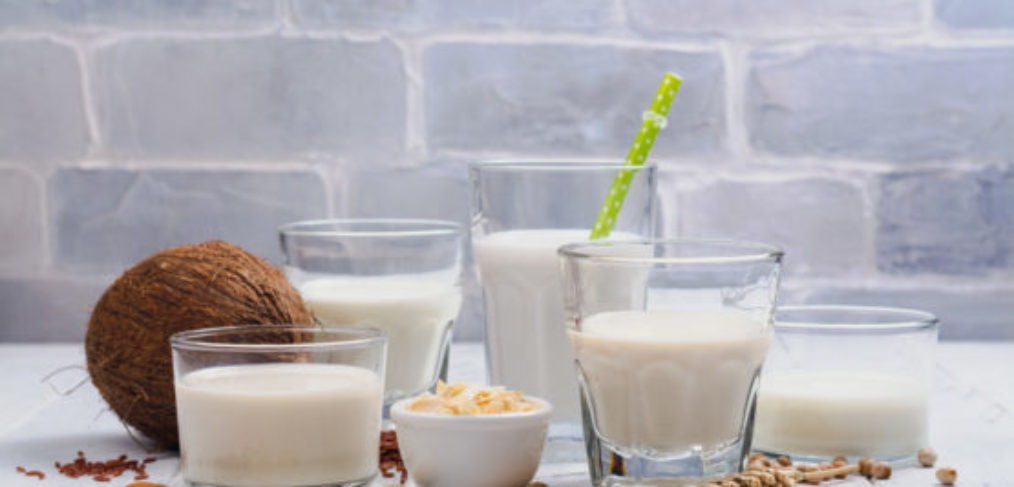Milking the Mylks: What’s the Best Option of the Plant-Based ‘Milks’?

Soy milk. Almond Milk. Hemp Milk. Coconut Milk. Oat Milk.
It’s a no brainer that consuming cow’s milk, for most people doesn’t come without consequence.
30 million to 50 million Americans are lactose intolerant, including 75 percent of African Americans and American Indians and 90 percent of Asian Americans. (1)
On top of that, most readily available milk products are sourced from what is referred to as a CAFO (concentrated animal feeding operation); an investigation by The Washington Post revealed that even some milks from organic-labeled dairies are nothing more than CAFOs in disguise, selling higher-priced milk that is scarcely different from conventional CAFO dairy (2).
Furthermore, with the growing trend away from whole and even 2% to skim milk, the latter of which contains 12 grams of sugar, drinking a cup or more per day adds to the insidious amount of this addictive substance consumed en masse, often unintentionally due to its tendency to be hidden in a vast array of processed food-products.
In addition, cow’s milk is acidic; the pH of milk is 6.7 to 6.9, making it slightly below neutral and therefore acid-forming. What does the body do in an attempt to bring the body’s pH to alkaline? It draws calcium from bones to buffer excess acidity which, over time, can weaken bones and increase the risk of osteoporosis (3).
For all of the reasons above, it’s not surprising that we sought other options to take the place of the drink that arguable might have best been left for the population it was truly meant for: calves.
Enter the nut, seed and grain based ‘milks’.
Call them milk, milked or mylk, what’s the deal on which of the plant-derived liquids are truly the best options for us in terms of nutrient density, flavor, texture and most importantly, least potential negative impact on gut health?
Certainly not soy milk.
With 93% of the soy products we have in the US being GMO (4), milks rendered from this inflammatory legume aren’t consumed without consequence. Soy is inflammatory with its high levels of Omega 6s; most Americans are getting 20 times the amount of omega-6s than needed which is extremely problematic, considering omega-6s are inflammation-causing, fat-storing, and weight-gain-inducing (5). In addition, with its high concentration of phyto estrogens, soy is the one of the most prolific offenders when it comes to hormonal imbalances in both men and women. Last but not least, soybeans contains anti-nutrients, including phytic acid (from phytates), which binds and prevents mineral absorption, especially zinc, calcium, and magnesium, leading to malnutrition as well as contributing to leaky gut.
Enter the nut and seed milks… any better?
Perhaps, but sourcing and preparation is key. In this category we see almond and hemp milk most often, with a growing occurrence of coconut milk.
While this group doesn’t contain the harmful plant estrogens, it can still be problematic in terms of creating inflammation as almonds are also high in Omega 6s and low in Omega 3s. Additionally, there is a growing awareness about the amount of water required to grow almonds, which in large scale can contribute to drought conditions globally. (6)
Another thing to keep in mind if purchasing commercially prepared almond or hemp milks is the addition of unfavorable ingredients. Be on the lookout for added sugars, stabilizers such as the gums (xanthan, carrageenan and guar), all of which contain anti nutrients of their own, as well as anything you cannot identify as a food.
How about milked oats?
Environmentally more friendly versus almonds, but still grain-based and thus still with anti-nutrient properties from phytates (7), thereby contributing to inflammation and leaky gut. Less than wheat, undoubtedly, but not without potential harm.
And the winner?
Coconut!
My personal favorite as well and specifically when sourced properly; as in not in a can or tetra pack. You can make your own if you happen to live in a tropical area; simply blend fresh coconut water right out of the coconut with fresh coconut meat from the same nut / seed / fruit (coconut is actually all of the above! (8). Plus, coconut has anti-inflammatory properties as well as vitamin E, vitamin K and the essential fatty acids. If you’re not in Hawaii, a good option is to buy a fair trade coconut butter, place the glass jar in a pan of simmering water until it melts, then mix with an amount of filtered water in your blender to create the desired thickness for whatever you’re preparing.
Worried about how you’re getting calcium without drinking milk? Fear not as all you need to do is get your greens in. A cup of collard greens has 357 mg of calcium versus 306 mg of calcium in dairy milk, per the Harvard School of Public Health and without any of the acid forming, bone-leeching properties!
Once again, everything we need is available to us if we go straight to the source: in season, local, plants in abundance (mostly veggies) paired with ample natural fats and a touch of mindfully sourced protein.
It’s. Just. Food.
(1) https://news.cornell.edu/stories/2005/06/lactose-intolerance-linked-ancestral-struggles-climate-diseases
(2) https://articles.mercola.com/sites/articles/archive/2017/05/16/organic-dairy-milk-may-not-be-organic.aspx
(3) https://www.drweil.com/diet-nutrition/diets-weight-loss/the-acid-alkaline-diet-eating-to-protect-bones/
(4) https://www.huffingtonpost.com/margie-kelly/genetically-modified-food_b_2039455.html
(5) https://www.ncbi.nlm.nih.gov/pmc/articles/PMC4808858/
(6) https://www.theguardian.com/lifeandstyle/shortcuts/2015/oct/21/almond-milk-quite-good-for-you-very-bad-for-the-planet
(7) https://draxe.com/antinutrients/
(8) https://www.scienceabc.com/nature/is-coconut-a-seed-a-fruit-or-a-nut.html





